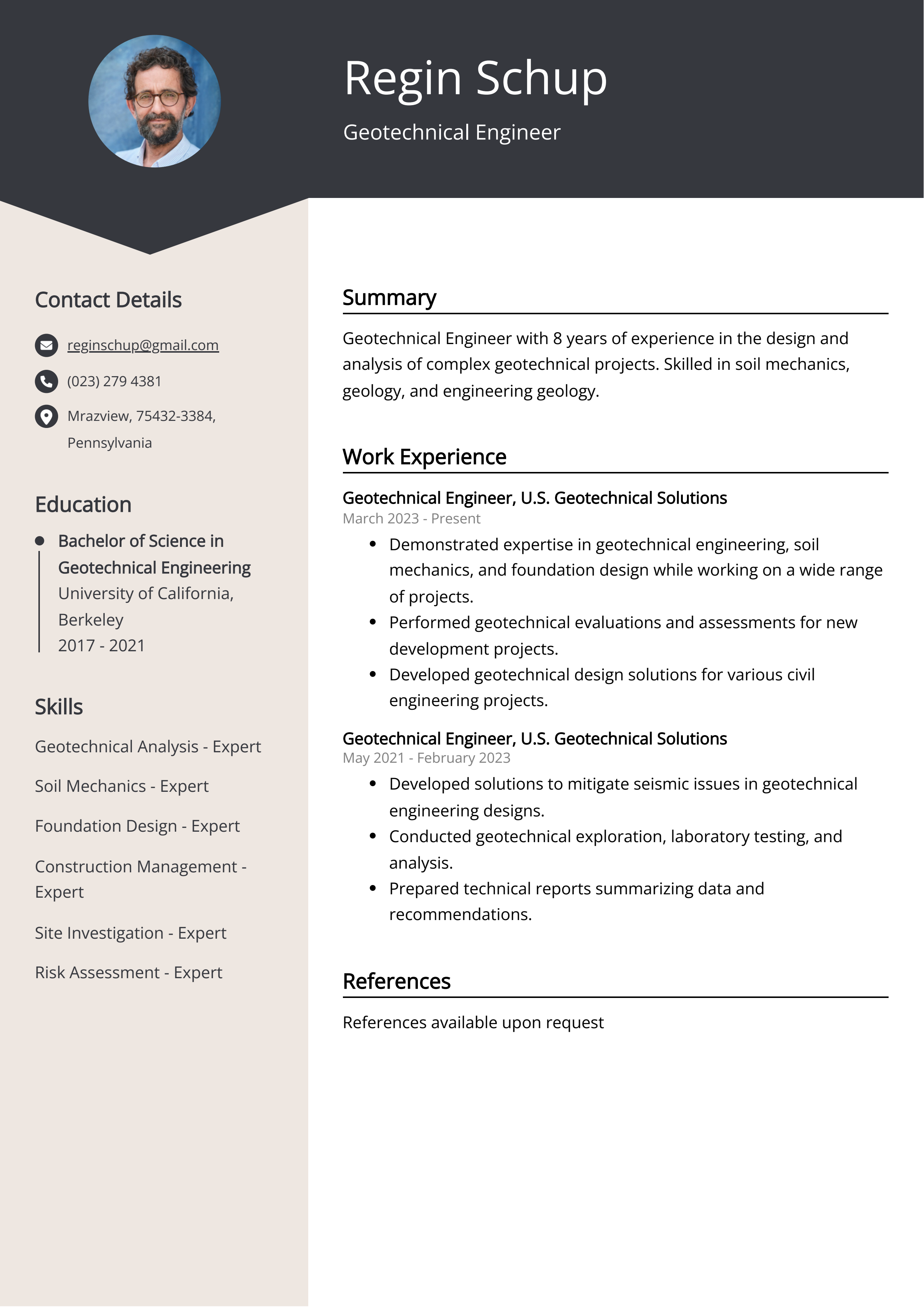The 6-Minute Rule for Geotheta
The 6-Minute Rule for Geotheta
Blog Article
How Geotheta can Save You Time, Stress, and Money.
Table of ContentsAbout GeothetaThe Buzz on GeothetaThe 10-Minute Rule for GeothetaThe 7-Minute Rule for GeothetaThe Basic Principles Of Geotheta

They carry out site investigations, accumulate samples, perform lab examinations, and examine information to review the viability of the ground for building projects - Tailings Engineer. Based upon their searchings for, geotechnical designers supply suggestions for structure layout, slope security, retaining structures, and mitigation of geotechnical dangers. They collaborate with other professionals, such as designers, structural engineers, and building teams, to make certain that geotechnical factors to consider are integrated into the total project design and implementation
By examining the behavior and buildings of soil and rock, they can recognize possible geotechnical hazards such as landslides, soil negotiation, or slope instability. Their competence assists protect against failings or mishaps that could endanger lives and residential property. Here are some detailed obligations and duties of a geotechnical engineer: Site Examination: Geotechnical designers conduct site investigations to gather data on subsurface problems.
They interpret the data to comprehend the residential or commercial properties and behavior of the dirt and rock, including their stamina, leaks in the structure, compaction qualities, and groundwater conditions. Geotechnical Analysis and Layout: Geotechnical engineers assess the data gathered during site investigations to examine the stability and suitability of the website for building jobs. They carry out geotechnical calculations and modeling to assess factors such as bearing capacity, negotiation, slope stability, side planet pressures, and groundwater flow.
Geotheta Can Be Fun For Anyone
Structure Design: Geotechnical engineers play a vital role in making foundations that can securely support the intended framework. They examine the soil problems and lots requirements to determine the suitable structure kind, such as superficial foundations (e.g., footings), deep structures (e.g (https://trello.com/u/geotheta)., stacks), or specialized methods like soil improvement. They consider factors such as settlement limits, bearing capability, and soil-structure communication to develop ideal foundation layouts
They examine building plans, monitor website activities, and perform area assessments to verify that the style suggestions are complied with. If unexpected geotechnical problems develop, they evaluate the situation and give recommendations for remediation or modifications to the design. Threat Assessment and Reduction: Geotechnical engineers assess geotechnical threats and risks connected with the project site, such as landslides, liquefaction, or dirt erosion.

Cooperation and Interaction: Geotechnical designers work carefully with various other professionals involved in a project, such as architects, architectural engineers, and construction teams. Reliable communication and collaboration are vital to integrate geotechnical considerations into the overall job design and construction procedure. Geotechnical engineers give technological expertise, response queries, and guarantee that geotechnical requirements are met.
9 Easy Facts About Geotheta Described
Right here are some sorts of geotechnical designers: Structure Designer: Foundation engineers concentrate on developing and analyzing foundations for frameworks. They assess the dirt problems, lots demands, and website qualities to determine the most suitable structure kind and layout, such as shallow foundations, deep foundations, or specialized techniques like pile structures.
They review the aspects influencing incline security, such as dirt buildings, groundwater conditions, and incline geometry, and establish methods to avoid slope failings and alleviate threats. Quake Engineer: Quake engineers specialize in assessing and making structures to endure seismic pressures. They analyze the seismic risk of a site, assess soil liquefaction capacity, and establish seismic style requirements to guarantee the security and resilience of frameworks throughout quakes.
They do area testing, collect samples, and evaluate the gathered information to identify the dirt residential properties, geologic developments, and groundwater conditions at a site. Geotechnical Instrumentation Engineer: Geotechnical instrumentation engineers concentrate on surveillance and measuring the behavior of soil, rock, and frameworks. They mount and maintain instrumentation systems that keep an eye on elements such as dirt negotiation, groundwater levels, slope activities, and architectural displacements to evaluate performance and provide very early cautions of potential concerns.
An Unbiased View of Geotheta
They conduct tests such as triaxial examinations, debt consolidation examinations, direct shear tests, and leaks in the structure examinations to collect information for geotechnical evaluation and layout. Geosynthetics Engineer: Geosynthetics designers specialize in the style and application of geosynthetic products, such as geotextiles, geogrids, and geomembranes. They utilize these products to improve soil security, reinforce slopes, give drainage options, and control erosion.
They have a tendency to be investigatory individuals, which means they're intellectual, introspective, and investigative. They are interested, systematic, sensible, logical, and sensible. Some visit this web-site of them are additionally social, meaning they're kind, charitable, cooperative, patient, caring, practical, understanding, skillful, and friendly - Consulting Engineer.
In the workplace setting, geotechnical designers make use of specialized software program devices to do computations, produce designs, and evaluate data. They prepare records, review job requirements, interact with customers and employee, and coordinate project tasks. The office setup provides a helpful setting for study, analysis, and partnership with other professionals entailed in the job.
9 Simple Techniques For Geotheta
They frequently see job sites to conduct website examinations, assess geotechnical conditions, and collect data for evaluation. These sees involve taking a trip to different places, sometimes in remote or tough terrains. Geotechnical engineers might perform soil sampling, conduct tests, and screen building tasks to guarantee that the geotechnical facets of the project are being applied correctly.
Geotechnical designers also operate in specialized geotechnical labs. In these centers, they conduct experiments, do tests on dirt and rock examples, and evaluate the design properties of the products. Geotechnical research laboratory engineers work extensively in these environments, managing screening equipment, operating tools, and videotaping data. They team up with other lab team to ensure precise and reliable testing results.
Report this page